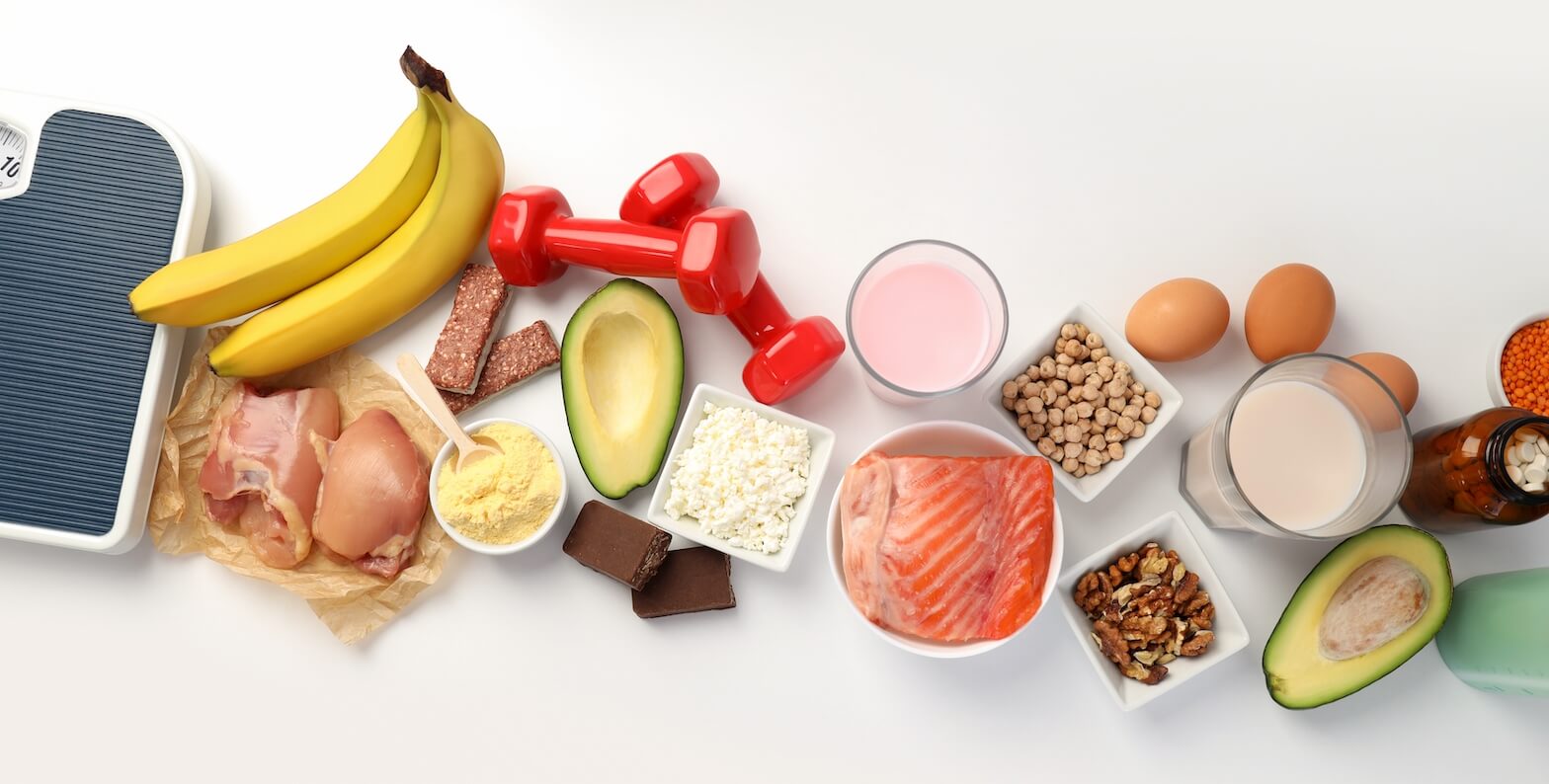WHAT ARE MACRONUTRIENTS?
Macronutrients are organic compounds required in large amounts to sustain vital human body processes. They give us the energy to maintain body functions, like digesting food, breathing, and carrying out our daily activities, such as working and exercising.
WHICH ARE THE MACRONUTRIENT GROUPS?
Macronutrients are divided into three groups: proteins, carbohydrates, and fats.
PROTEIN
Protein is an essential nutrient and vital because it is involved with every biological process in the human body.
These biological processes include.
- Tissue repair and production
- Hormone production
- Enzyme production
- Immune function
- Energy production
- Maintaining healthy hair, skin, and nails.
Proteins are made up of multiple small components called amino acids. Think of proteins like a pearl bracelet – the ‘pearls’ being amino acids and the ‘thread’ being the bonds that attach the amino acids to form a protein. Humans need twenty amino acids. Some of these can be made by the human body itself, but nine cannot and these are considered essential. The nine essential amino acids are histidine, isoleucine, leucine, lysine, methionine, phenylalanine, threonine, tryptophan, and valine. Essential means they must be sourced from the diet.
Protein food sources are classified as complete or incomplete proteins based on the presence of the nine essential amino acids. Complete proteins contain all nine essential amino acids. These high-quality proteins mainly come from animal sources, such as eggs, chicken, beef, lamb, and pork.
Complete protein sources can also come from plant foods, such as quinoa, buckwheat, soy, and quorn (a meat substitute made from a fungus).
Incomplete proteins do not contain all nine essential amino acids and are found in many plant-based foods. Examples of incomplete protein sources include:
- Grains such as rice, pasta, and bread (lack/low in threonine, leucine, lysine, and histidine)
- Legumes such as beans, peas, and lentils (low in methionine)
- Starchy vegetables such as potato, pumpkin, and sweet potato (low in lysine)
- Nuts such as walnuts, macadamia, and almonds (low in threonine).
Incomplete proteins are often referred to as low-quality proteins; however, this can be misleading. They are still a valuable source of protein and can be combined in a meal to form a complete protein source, for example, peanut butter on whole-wheat toast or salad with chickpeas and sunflower seeds.
CARBOHYDRATES
Carbohydrates are organic compounds of sugars or starches. Carbohydrates have three fundamental roles in the human body; they provide the body with an immediate fuel supply, stored energy, and prebiotics for digestive health.
Carbohydrates can be classified into two main groups; these are known as simple carbohydrates and complex carbohydrates. Let’s learn about them.
Simple Carbohydrates.
These simple sugars are glucose, fructose (from fruit) and galactose (from dairy). These are the basic sugar molecules, and all carbohydrates, whatever the source, are broken down into these simple sugars.
These simple sugars are classified as follows.
Monosaccharides (one sugar molecule):
- Glucose is found in vegetables, grains, fruit and dairy.
- Fructose is found in fruit and honey.
- Galactose is found in milk, yoghurt and cheese.
Disaccharides (two sugar molecules):
- Sucrose (glucose + fructose), is found in sugar cane or sugar beets and made into table sugar when refined.
- Maltose (glucose + glucose), is found in wheat, cornmeal, barley and several ancient grains.
- Lactose (glucose + galactose), is found in dairy products, such as yoghurt, cheese and milk.
Complex Carbohydrates.
Complex carbohydrates comprise a long bond of numerous sugar molecules called oligosaccharides and polysaccharides. They contain starch and fibre. Starch is found in most vegetables, grains, and fruits. Foods rich in starch are excellent energy sources. Fibre is the part of the plant that cannot be digested and is passed into the large intestine. It slows the release of sugar into the bloodstream, increases satiety, improves gut flora (by acting as a prebiotic) and regulates bowel motions. The best carbohydrates sources to add to our diet are the oligo- and polysaccharides containing starch and fibre, such as beans, sweet potato, and wholegrain bread.
Sources of oligo- and polysaccharides are listed below.
Oligosaccharides (three to nine sugar molecules):
- Raffinose is found in beans, cabbage, brussel sprouts, broccoli, asparagus, and whole grains.
- Stachyose is found in human milk, green beans, soybeans, and other beans.
Polysaccharides (ten or more sugar molecules):
- Starch is found in potatoes, sweet potatoes, corn, and peas.
- Glycogen is found in fruits, starchy vegetables, and whole grains.
Cellulose is found in plants and used as a preservative, thickener, additive, and emulsifier in commercial products such as sauces, yoghurts, and whipped cream.
FATS
Dietary fat is not only an energy-yielding macronutrient, containing 37kJ per gram. Fat is found in the structure of all human body cells, and it has several other crucial roles in the human body, including:
- Helps with the regulation of hunger
- Provides the body with energy and stored energy
- Critical for normal nerve function
- Stores some vitamins (A, D, E and K)
- Maintains healthy cholesterol levels
- Forms the outer structure of all cells
- Maintains healthy hair, skin, and strong nails
- Improved brain function and brain development
- Improves efficiency and effectiveness of blood clotting when/if required
- Assists in reducing inflammation and increasing immunity
- Reduces cardiovascular disease risk
- Improves blood vessel elasticity
- Decreases the risk of depression and anxiety.
Indeed, fat is essential for our health, and a diet lacking a range of dietary fats can lead to poor health outcomes, including:
- Vitamin deficiency
- Hormone imbalances
- Increased hunger, and
- Skin problems.
A fat molecule is a fatty acid, typically a string of hydrogen and carbon molecules ending with a carboxylic group. Fatty acids can be classified by their degree of ‘saturation’, either saturated or unsaturated fats. Saturation refers to the number of double bonds between carbon and hydrogen molecules in the fatty acid. There are only single bonds in a saturated fatty acid; these fats are usually solid at room temperature. There are one or multiple double bonds or rings in unsaturated fatty acids, and these fats are usually liquid at room temperature.
Unsaturated fats are classified as mono- and polyunsaturated fats.
Mono-unsaturated, found in plant-based foods, as well as in meat and animal-based foods. These fats are found in olive oil, eggs, sunflower seeds, avocado, almonds, peanuts, cashews, pistachios, pork, pumpkin seeds, and olives.
- Mono-unsaturated fats may have some benefits when included in the diet, such as reducing cardiovascular disease risk and may help to reduce inflammation.
Polyunsaturated fat is found mainly in plant-based foods, plant oils like sunflower oil, flaxseed oil, and marine foods such as oily fish. Polyunsaturated fats include omega-3, omega-6 and omega-9 fats.
- Omega-3 plays a crucial role in brain health, vision, joint health, reducing inflammation, and promoting heart health. It is found in oily fish, (salmon and sardines), walnuts, flaxseeds and sesame seeds, olive oil, garlic, avocados, whole eggs, some dark green, leafy vegetables (spinach, kale, collards).
- Omega-6 is a type of polyunsaturated fat that has been cardioprotective (heart-healthy), thus decreasing the risk of heart disease. It is found in dairy (milk, cream, cheese, butter), nuts and seeds (sunflower seeds, pistachio nuts), olives and olive oil, evening primrose oil, eggs, vegetable oils (soybean, canola, sunflower), commercially baked products and deep-fried foods. While essential in the diet, these fats are often over-consumed in the Western diet. Overconsumption of Omega 6 fatty acids can have an inflammatory effect on the human body.
- Omega-9, This fat is not essential as your fat cells make omega-9 fat from the fatty acids your body doesn’t use as energy. It is also found in food, like olive oil, avocado oil, almonds, walnuts, fish, and animal fat. Like the other omegas, it helps regulate cholesterol levels in the blood.
Saturated Fats
- Saturated fats from healthy sources are typically found in animal products and some plant-based foods, found in animal fats (lard, tallow, ghee), full-fat dairy products (milk, yoghurt, cheese), coconut products (coconut oil, coconut milk and cream).
- Saturated fats from highly processed sources are less healthy fats and should be limited in the diet, found in processed foods (biscuits, cakes, pastries, pies, chips), processed meats (sausages, salami), and fast food (hot dogs, burgers, pizza, fried food).
It is recommended to source most fats from foods high in unsaturated fats. The World Health Organisation recommends only having about 10% of total fat intake from saturated fat.
Trans Fats
Trans fats are unsaturated fats made by a chemical reaction that changes the unsaturated vegetable fat to saturated fat. These fats are not naturally found in foods and are not essential in the human diet. They are known to increase the amount of LDL cholesterol in the blood, a risk factor for heart disease. Trans fats are manufactured and are usually found in heavily processed foods. It is found in hydrogenated margarine, processed baked goods (cakes, biscuits), processed, cooked meat foods (pies, hot dogs, pizza), and foods deep-fried in vegetable oils (hot chips, fish). Limiting energy intake from trans fats to less than 1% of daily energy intake is recommended.



